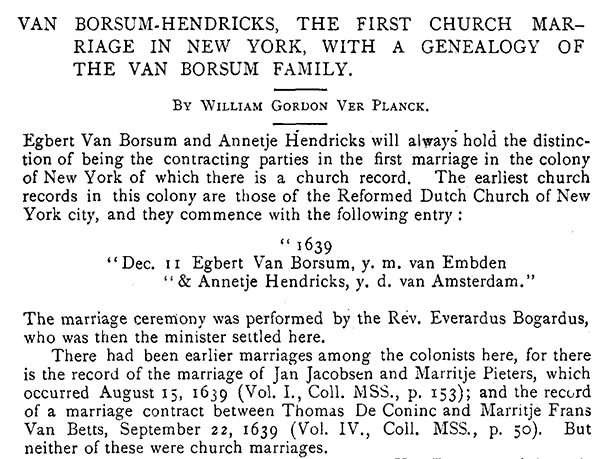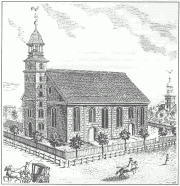During the 16th century, many Christians in the Netherlands broke with Rome and affiliated with Calvinist Protestantism, forming the Nederlands Hervormde Kerkor, or the Dutch Reformed Church.
Many of the leaders of the Dutch war for independence from Spain were a part of this church, as well as directors of the West India Company, which created the colony of New Netherland. The Dutch Reformed Church was a major presence in early colonial New York, and its records serve as a crucial genealogical source.
The Reformed Church is important for far more researchers than just those with Dutch roots - read on for some important facts about Reformed Churches in the Bronx and Manhattan to see if you might be overlooking their relevance to your own genealogy.
This blog is based on a guide to Reformed Church Records of New York City (Manhattan & Bronx), recently updated by an esteemed expert on the subject, Harry Macy Jr, who is the original author. This article, which can be accessed by NYG&B members in the New York Knowledge Base is a crucial resource for anyone who wants to find these types of records. It includes a comprehensive overview of all churches in this category, including where to find their existing records.
Regardless of whether or not you plan to actively research using these records, here are seven important facts that all researchers should know about Reformed Churches in Manhattan and the Bronx.
1. For a time, Dutch Reformed was the only permitted denomination in New Amsterdam
In New Amsterdam prior to the English takeover of 1664, the Dutch Reformed was the only denomination permitted to hold public worship.
Regardless of race or nationality, couples seeking to marry or have their children baptized came to the Dutch minister or dominee. So even if the subjects of your research weren't Dutch, if they lived in or around New Amsterdam during this time period, these records are a good place to look.
The universality of the city's earliest Dutch Reformed records and their marvelous detail make them an extremely important genealogical resource.
2. The church that holds the oldest religious marriage record in New York is still active to this day
The first Dutch Reformed services were held on Manhattan Island in 1628. Jonas Michaëlius was the leader of this first congregation, located at Fort Amsterdam.
This congregation still continues to this day as the Collegiate Church of New York City - although it has been active since 1628, records begin in 1639 (the church itself was not erected until 1642).
An 1895 issue of The Record suggests that this congregation holds the distinction of creating the oldest existing church marriage record in New York - the second congregation wasn't formed until 1642, and was located in Fort Orange, in the area of modern-day Albany.

3. The difference between collegiate and non-collegiate churches
More Dutch Reformed churches sprang up as the colony grew and expanded in the 1700s. Several other congregations were formed in the southern part of Manhattan, and all of these churches were networked together.
In other words, they were considered "collegiate" - this means they shared ministers and kept a single set of registers - important to know for research!
A church also existed from 1660 in Harlem, at the north end of Manhattan. Aside from these few, there were no other Dutch Reformed churches in the city until the 1800s.
During the 1800s and 1900s, many new Dutch Reformed churches were organized in the city, and most of them were non-collegiate.
Few of these churches still exist, but fortunately, many of their records have been preserved, and some are even available online (more on this below).
4. Early German New Yorkers attended Dutch Reformed churches
Many New Amsterdam settlers who arrived in the 1600s came from what is now Germany. This population included many adherents of German Reformed churches and were soon assimilated into the Dutch population and Dutch Reformed Church.
In the 1700s, more Germans immigrated to New York, and those who were Reformed continued to attend the Dutch churches.
As the German population of New York grew, so did the demand for a church that conducted services in German - eventually, in 1758 the German Reformed Church in the City of New York was founded. A century later, the great wave of German immigration that began in the 1840s led to the creation of many other German Reformed congregations in the city.
For more information on early German churches of New York (including the five boroughs and parts of Hudson County, New Jersey) researchers should explore Richard Haberstroh’s invaluable research guide, The German Churches of Metropolitan New York.
This work has been digitized, and NYG&B members can access it in our eLibrary. A print version is also available for purchase in the NYG&B store.
5. Ancestry.com Dutch Reformed Databases
There are two collections of digitized Dutch Reformed Church records available on Ancestry.com, which include records from some of the now-defunct churches mentioned previously in this article.
Both collections can be found via the Ancestry.com card catalog, and contain additional Dutch Reformed records that include locations outside of New York City and New York State (researchers can filter out these locations as needed).
A note of caution: The databases are nearly identical, but not entirely - some of the exact same records appear in both databases, but a few appear in only one of the two.
Also, researchers are advised to browse known congregations of interest in addition to running any name searches - some desired names may not show up if an indexer misread a name or the search does not cover all variant spellings. It's a good idea to start with congregations you know the family attended or congregations that were located close to their known address.
In his full guide, Harry Macy details the exact holdings of the Ancestry.com databases, as well as the differences between them.
6. The NYG&B has digitized many Reformed Church records
Over the centuries, the NYG&B has transcribed and digitized many records for Reformed Churches in New York City and beyond.
Our substantial collection of religious records include over 40 Dutch Reformed churches throughout the state, as well as records of some of the earliest congregations on the island of Manhattan.
A number of transcriptions also exist in the archives of The Record, which has been publishing rare record set transcriptions, compiled genealogies, and more for nearly 150 years. The full guide to Reformed Church records in the Bronx and Manhattan lists specific volumes and issues of interest, all which can be accessed via The Record Archives in the NYG&B eLibrary.
7. Bronx church records begin much later, with one exception
What is now the Bronx was formerly part of Westchester County and was largely rural until the mid-1800s, when New York City’s population began expanding northward from Manhattan Island.
In 1874 the towns west of the Bronx River and south of the city of Yonkers were annexed to the City, and in 1895 the corresponding area east of the river also became part of the City.
The records of most Reformed churches in this borough begin in the mid-1800s, with one exception - the Fordham Reformed Protestant Dutch Church was originally organized in 1696 by the collegiate churches that owned Fordham Manor. It lapsed in 1776, but was reorganized in 1802 and still exists today as Fordham Manor Reformed Church.
We hope this article has served as a basic introduction to these religious congregations and their important genealogical records. For those seriously considering researching Reformed Church records of Manhattan and the Bronx, we recommend reading Harry Macy's full guide in detail and keeping it handy during research.
Read More
-
Using the NYG&B's Religious Records Collection
-
New York Vital Records Substitutes: Religious Records
-
Researching New York Dutch Families: A Checklist Approach
-
Kings County Colonial Church Records
-
Religious Records of Queens and Nassau Counties
-
Finding Birth, Marriage, and Death Records in New York State
